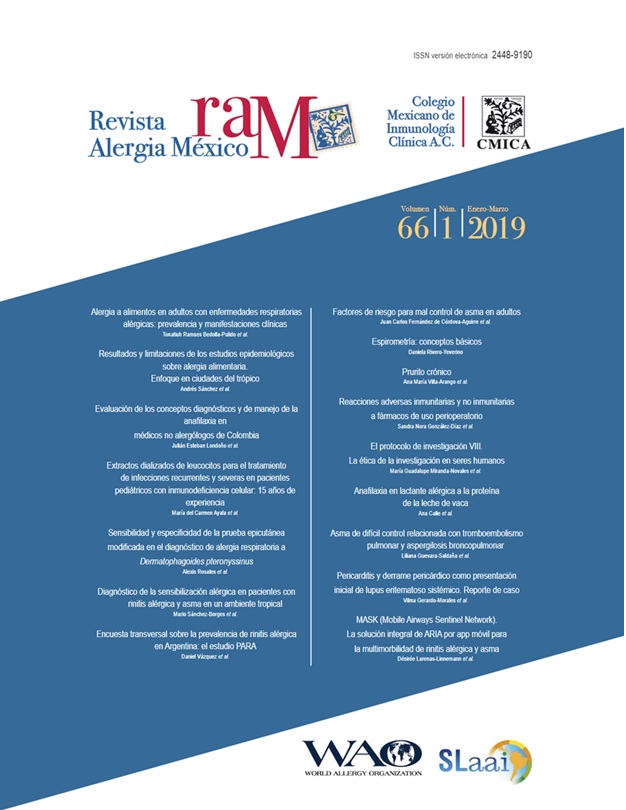Resumen
Antecedentes: La alergia a alimentos se considera un problema típico de la población pediátrica, sin embargo, los adultos se ven afectados cada vez con mayor frecuencia.
Objetivo: Determinar la prevalencia de alergia a los alimentos en pacientes con rinitis alérgica y asma, así como los alimentos y los síntomas más relacionados con este problema.
Métodos: Mediante un estudio transversal se analizaron los datos de 257 adultos con asma o rinitis alérgica. La información relacionada con la alergia a los alimentos se obtuvo por entrevista estandarizada. Se calcularon intervalos de confianza (IC) a 95 % para proporciones.
Resultados: La prevalencia de alergia a alimentos fue de 17.5 % (IC 95 % = 13.3-22.6). Soya, camarón, almendra, aguacate y cacahuate fueron los alimentos que principalmente provocaron molestias; 35.6 % de los pacientes fue alérgico a un alimento, 17.8 % a dos y 17.8 % a tres. Las manifestaciones más frecuentes fueron las orales (62.2 %), prurito en faringe, lengua y paladar; las respiratorias (26.7 %), disnea y estornudos; y las cutáneas (26.7 %), comezón y ronchas.
Conclusiones: La alergia a alimentos en adultos con asma o rinitis alérgica es un problema frecuente. Los síntomas orales son la principal molestia en este tipo de pacientes y principalmente son provocados por la soya.
Referencias
Kumar R, Kumari D, Srivastava P, Khare V, Fakhr H, Arora N, et al. Identification of IgE-mediated food allergy and allergens in older children and adults with asthma and allergic rhinitis. Indian J Chest Dis Allied Sci. 2010;52(4):217-224.
Rentzos G, Johanson L, Sjölander S, Telemo E, Ekerljung L. Self-reported adverse reactions and IgE sensitization to common foods in adults with asthma. Clin Transl Allergy. 2015;5:25. DOI: 10.1186/s13601-015-0067-6
Inam M, Shafique RH, Roohi N, Irfan M, Abbas S, Ismail M. Prevalence of sensitization to food allergens and challenge proven food allergy in patients visiting allergy centers in Rawalpindi and Islamabad, Pakistan. Springerplus. 2016;5(1):1330. DOI: 10.1186/s40064-016-2980-0
Burney PG, Potts J, Kummeling I, Mills EN, Clausen M, Dubakiene R, et al. The prevalence and distribution of food sensitization in European adults. Allergy. 2014;69(3):365-371. DOI: 10.1111/all.12341
Valle-Rodríguez I, Huerta-López JG, Huerta-Hernández RE. Alergia a alimentos. Alerg Asma Inmunol Pediatr. 2017;26(1):5-15. Disponible en: http://www.medigraphic.com/pdfs/alergia/al-2017/al171b.pdf
Waserman S, Watson W. Food allergy. Allergy Asthma Clin Immunol. 2011;7(Suppl 1):S7. DOI: 10.1186/1710-1492-7-S1-S7
Ramesh M, Lieberman JA. Adult-onset food allergies. Ann Allergy Asthma Immunol. 2017;119(2):111-119. DOI: 10.1016/j.anai.2017.05.014
James JM. Respiratory manifestations of food allergy. Pediatrics. 2003;111 (6 Pt 3):1625-1630. Disponible en: https://pediatrics.aappublications.org/content/111/Supplement_3/1625.long
Pénard-Morand C, Raherison C, Kopferschmitt C, Caillaud D, Lavaud F, Charpin D, et al. Prevalence of food allergy and its relationship to asthma and allergic rhinitis in schoolchildren. Allergy. 2005;60(9):1165-1171. DOI: 10.1111/j.1398-9995.2005.00860.x
Patelis A, Alving K, Middelveld R, James A, Ono J, Ohta S, et al. IgE sensitization to food allergens and airborne allergens in relation to biomarkers of type 2 inflammation in asthma. Clin Exp Allergy. 2018;48(9):1147-1154. DOI: 10.1111/cea.13165.
Silva LA, Silva AF, Ribeiro ÂC, Silva AO, Vieira FA, Segundo GR, et al. Adult food allergy prevalence: reducing questionnaire bias. Int Arch Allergy Immunol. 2016;171(3-4):261-264. DOI: 10.1159/000453036
Lee SH, Ban GY, Jeong K, Shin YS, Park HS, Lee S, et al. A retrospective study of Korean adults with food allergy: differences in phenotypes and causes. Allergy Asthma Immunol Res. 2017;9(6):534-539.
Bedolla-Barajas M, Bedolla-Pulido TR, Camacho-Peña AS, González-García E, Morales-Romero J. Food hypersensitivity in Mexican adults at 18 to 50 years of age: a questionnaire survey. Allergy Asthma Immunol Res. 2014;6(6):511-516. DOI: 10.4168/aair.2014.6.6.511
Van Kampen V, De Blay F, Folletti I, Kobierski P, Moscato G, Olivieri M, et al. EAACI position paper: skin prick testing in the diagnosis of occupational type I allergies. Allergy. 2013;68(5):580-584. DOI: 10.1111/all.12120
Sicherer SH, Muñoz-Furlong A, Godbold JH, Sampson HA. US prevalence of self-reported peanut, tree nut, and sesame allergy: 11-year follow-up. J Allergy Clin Immunol. 2010;125(6):1322-1326. DOI: 10.1016/j.jaci.2010.03.029
Larenas-Linnemann D, Salas-Hernández J, Vázquez-García JC, et al. Guía mexicana del asma 2017: GUIMA 2017. Rev Alerg Mex. 2017;64(Supl 1):s11-s128. Disponible en: http://revistaalergia.mx/ojs/index.php/ram/article/view/272/406
Brożek JL, Bousquet J, Agache I, Agarwal A, Bachert C, Bosnic-Anticevich S, et al. Allergic RHINITIS and its Impact on Asthma (ARIA) guidelines-2016 revision. J Allergy ClinImmunol. 2017;140(4):950-958. DOI: 10.1016/j.jaci.2017.03.050
Osterballe M, Mortz CG, Hansen TK, Andersen KE, Bindslev-Jensen C. The prevalence of food hypersensitivity in young adults. Pediatr Allergy Immunol. 2009;20(7):686-692. DOI: 10.1111/j.1399-3038.2008.00842.x

Esta obra está bajo una licencia internacional Creative Commons Atribución-NoComercial 4.0.
Derechos de autor 2019 Revista Alergia México

